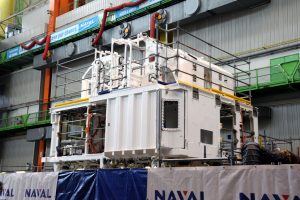
Naval Group launches the new generation first-of-class Suffren SSN
 With a ceremony presided over by the President of the French Republic Emmanuel Macron, at the presence of the Australian Defence Minister Linda Reynolds and French Parliament representatives welcomed by Hervé Guillou, Chairman and Chief Executive Officer of Naval Group and Vincent Martinot-Lagarde, Director of the Barracuda program, Naval Group formally launched at Cherbourg shipyard the Suffren, the first of a new-generation class of six nuclear attack submarine on contract under the Barracuda programme.
With a ceremony presided over by the President of the French Republic Emmanuel Macron, at the presence of the Australian Defence Minister Linda Reynolds and French Parliament representatives welcomed by Hervé Guillou, Chairman and Chief Executive Officer of Naval Group and Vincent Martinot-Lagarde, Director of the Barracuda program, Naval Group formally launched at Cherbourg shipyard the Suffren, the first of a new-generation class of six nuclear attack submarine on contract under the Barracuda programme.
The latter is designed to replace the in-service Rubis-class of sous-marin nucléaire d’attaque (SNA) as designated by French Navy, and service with the Marine Nationale until the 2060s. The first of Rubis-class SNA, the FS Saphir, was retired last week at the end of her final cruise.
 The next-generation submarine will be floated soon and will continued a series of verification and validation activities and nuclear reactor first-refueling in advance to the first at-sea trials in the first-quarter of 2020 and delivery to the French Navy according to plans, by middle next-year.
The next-generation submarine will be floated soon and will continued a series of verification and validation activities and nuclear reactor first-refueling in advance to the first at-sea trials in the first-quarter of 2020 and delivery to the French Navy according to plans, by middle next-year.
Naval Group is the overall prime contractor for the submarine design, construction and delivery while TechnicAtome is the prime contractor for the nuclear reactor. The French Armament Directorate (DGA) is in charge of the overall programme, with the Atomic Energy and Alternative Energies Commission (CEA) for the nuclear reactor.
“We are proud to have presented to the President of the French Republic the first submarine of the Barracuda-class, a symbol of our exceptional know-how and our ability to master the most advanced technologies and the most complex products. The construction of the Suffren is a collective success, the result of a strong cooperation with our long-standing partners: the French Navy and the French Armament Directorate (DGA), but also the Atomic Energy and Alternative Energies Commission (CEA), TechnicAtome and all the manufacturers of the sector. Now, we are all focused on finalising the Suffren tests at the shipyard, with the start-up of the nuclear boiler room in the coming weeks, but also on producing the complete series. Maintaining our knowledge and adapting to new technologies are among our main priorities”, said Hervé Guillou, Chairman and Chief Executive Officer of Naval Group.
 Launched in 1998, the Barracuda programme saw the contract award in 2006 and the beginning of construction of the first-of-class in 2007. The Duguay Trouin (second-in-class), Tourville (3rd), De Grasse (4th), Rubis (5th) and Casabianca (6th), are in different stage of production, with the second boat ready to begin the hull assembly in the in-coming days. In occasion of the ceremony, the French MoD has announced the contract award on last 14th June of the sixth submarine while Naval Group has already started to procure or build long-lead items for the last boat. According to the Loi de Programmation Militaire (LPM) 2019-2025, all first four submarines will be delivered by 2025, while the last two will follow by 2029.
Launched in 1998, the Barracuda programme saw the contract award in 2006 and the beginning of construction of the first-of-class in 2007. The Duguay Trouin (second-in-class), Tourville (3rd), De Grasse (4th), Rubis (5th) and Casabianca (6th), are in different stage of production, with the second boat ready to begin the hull assembly in the in-coming days. In occasion of the ceremony, the French MoD has announced the contract award on last 14th June of the sixth submarine while Naval Group has already started to procure or build long-lead items for the last boat. According to the Loi de Programmation Militaire (LPM) 2019-2025, all first four submarines will be delivered by 2025, while the last two will follow by 2029.
Once floated soon, the Suffren SNA will have her nuclear reactor refuelled leading to the light-up and the beginning of at-sea trials in the first quarter of 2020, before reaching its naval base in Toulon by summer 2020. According to Naval Group and DGA, the Suffren is expected to also complete weapon fire trials next year, with the aim to complete them before handed over to French Navy.
The Barracuda programme and its development of the next-generation Suffren-class boats represents a huge technological advancement in term of capabilities and signature reduction, and thanks to this, the Marine Nationale will be able to accomplish a wider range of operations and fulfill the requirements for a platform and combat system able to remain in service until the 2060s. In addition to the traditional missions assigned by French Navy to its Rubis-class including the protection of SSBN (SNLE as designated by the Marine Nationale) and the battle group based on the Charles de Gaulle aircraft carrier, the Suffren-class SNA will be able to ensure the deep land-strike with the employment of the MBDA MdCN naval cruise missile and to embark and support Special Forces operators with the integration of a frogmen trunk and the optional use of a Dry Deck Shelter (DDS) enabling the deployment of commando underwater vehicles and in the future autonomous vehicles.
 With a surface and submerged displacement of respectively 4,700 and 5,300 tonnes, roughly double the Rubis-class submarine, a length and diameter of respectively 99 and 8,8 meters, the new Suffren SNA is equipped with a new generation steam/electric hybrid propulsion system offering a maximum speed of over 25 knots. The new hybrid propulsion is centered on an enhanced K15 pressurized water reactor feeding three turbines, the most powerful driving the submarine shaft providing the maximum speed. The other two smaller turbines are connected to the same number of generators which provide the electrical power for respectively the two electric propulsion motors at operational lower speeds, as well as the platform and combat system components.
With a surface and submerged displacement of respectively 4,700 and 5,300 tonnes, roughly double the Rubis-class submarine, a length and diameter of respectively 99 and 8,8 meters, the new Suffren SNA is equipped with a new generation steam/electric hybrid propulsion system offering a maximum speed of over 25 knots. The new hybrid propulsion is centered on an enhanced K15 pressurized water reactor feeding three turbines, the most powerful driving the submarine shaft providing the maximum speed. The other two smaller turbines are connected to the same number of generators which provide the electrical power for respectively the two electric propulsion motors at operational lower speeds, as well as the platform and combat system components.
Thanks to a highly-efficient hydrodynamic hull and advanced technologies and devices applications in the acoustic-reduction domain, the new SNA has a higher maximum silent speed and further reduced signature thanks also to a pump-jet propeller compared to Rubis-class platforms in addition to be more maneuverable thanks to an X-shaped stern rudder assembly. The Suffren-class will also have a 70-day autonomy (compared to 45 of the Rubis-class) and is planned to be available more than 270 days per year. The new Suffren-class will also require changing their nuclear core once every ten years as well as conduct only a ten-week maintenance period every year, whereas the Rubis-class boats required two of 5 weeks.
While being capable to reach a depth of 350 meters, thanks to the highly automated platform and combat systems, the Suffren-class SNAs have a crew of 65 elements and will be able to accommodate and support up to 15 Special Forces operators. In order to get acquainted to the new technologies and system management, the French Navy’s submariners have been formed for three years on dedicated platform and system simulators. The Suffren crew, constituted by experienced submarines, has been created on 11 July under Commander Axel Roche. The Barracuda programme also includes the building and delivery by Naval Group of two DDS able to accommodate the new PSM-3G advanced swimmer delivery vehicle.
 The Suffren-class SNAs are equipped with a further evolved and customized integrated platform management system and SYCOBS submarine command management system compared to latest French Navy’s SSBN and provided by Naval Group. Thanks to the introduction of non-penetrating electronic masts supplied by Safran, the command operation center could be accommodated where is most appropriated compared to the conventional equipped submarine which dictated the COC to be installed under the sail. The CMS manages an enriched Thales-provided communications suite including VLF to UHF radios, data links and SATCOM as well as a sonar suite provided by the same company. The latter is based on bow-mounted cylindrical array, mine and obstacle avoidance, intercept arrays and planar flank arrays, in addition to a passive towed array and underwater communications. Thales also provides the EW suite based on an ESM/ELINT system. The new SNA is equipped with four 533 mm NATO standard torpedo launching tubes and can accommodate up to 24 weapon systems, doubling the Rubis-class capacity and including the MBDA MdCN naval cruise missile and SM39 Block 2 Mod2 anti-ship missile, as well as the new Naval Group F21 heavy-weight torpedo (HWT), making the Suffren-class SNAs the first to receive the new generation underwater weapon system. The new platform is also capable of laying mines.
The Suffren-class SNAs are equipped with a further evolved and customized integrated platform management system and SYCOBS submarine command management system compared to latest French Navy’s SSBN and provided by Naval Group. Thanks to the introduction of non-penetrating electronic masts supplied by Safran, the command operation center could be accommodated where is most appropriated compared to the conventional equipped submarine which dictated the COC to be installed under the sail. The CMS manages an enriched Thales-provided communications suite including VLF to UHF radios, data links and SATCOM as well as a sonar suite provided by the same company. The latter is based on bow-mounted cylindrical array, mine and obstacle avoidance, intercept arrays and planar flank arrays, in addition to a passive towed array and underwater communications. Thales also provides the EW suite based on an ESM/ELINT system. The new SNA is equipped with four 533 mm NATO standard torpedo launching tubes and can accommodate up to 24 weapon systems, doubling the Rubis-class capacity and including the MBDA MdCN naval cruise missile and SM39 Block 2 Mod2 anti-ship missile, as well as the new Naval Group F21 heavy-weight torpedo (HWT), making the Suffren-class SNAs the first to receive the new generation underwater weapon system. The new platform is also capable of laying mines.
All the skills within the group are called upon to design and produce the Suffren and the following of the Barracuda series. All Naval Group sites are simultaneously mobilised. With this program, Naval Group irrigates the French industry with more than 10,000 people involving 800 companies.
Photos by Luca Peruzzi
